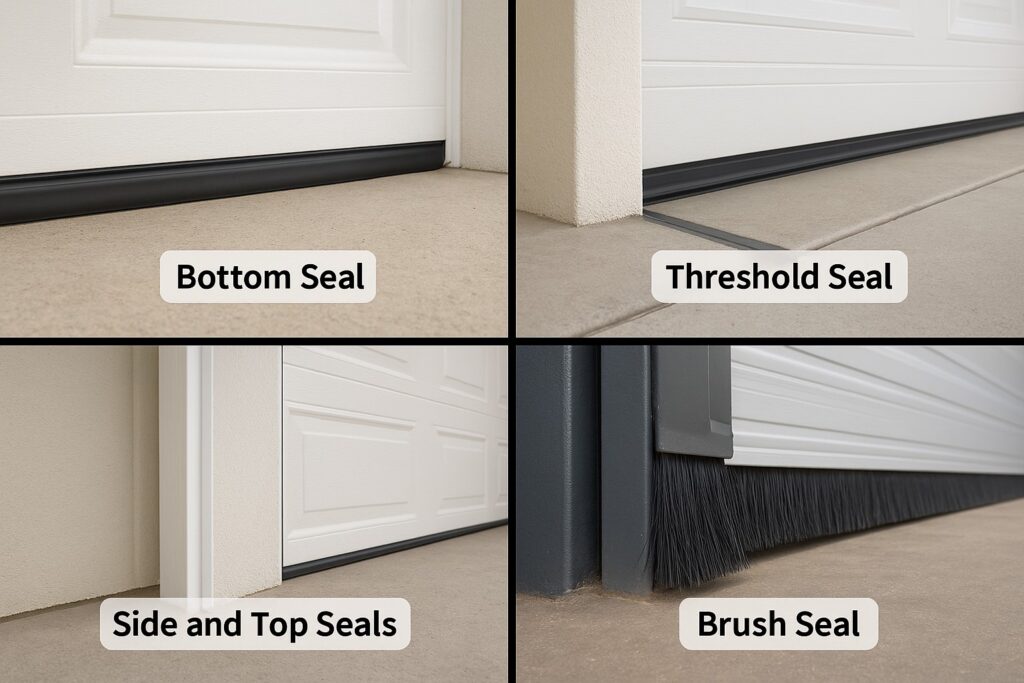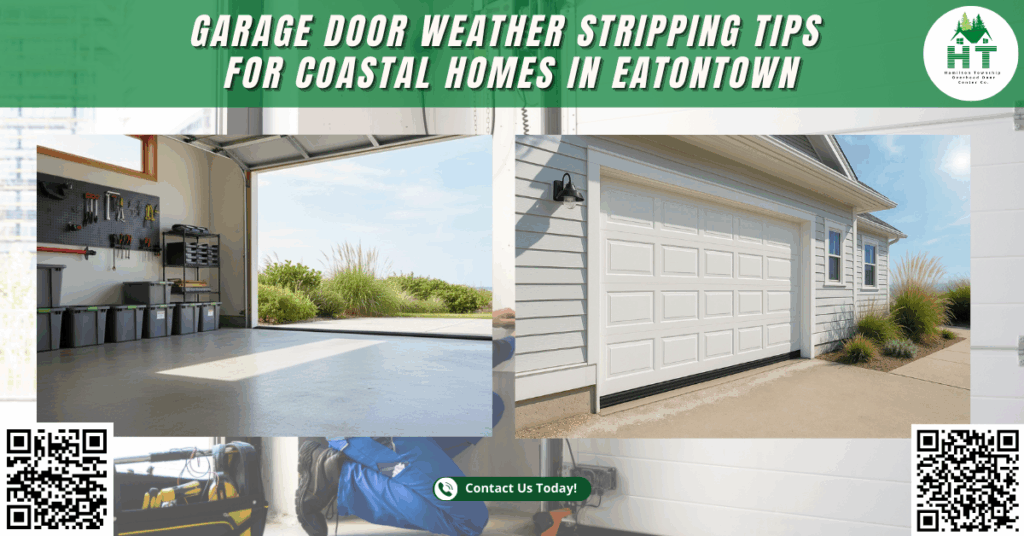A Real Coastal Weather Stripping Wake-Up Call
Last autumn, our team responded to an urgent call from a homeowner in Eatontown. After a powerful storm rolled in from the Atlantic, their garage was flooded with rainwater, and the space was filled with leaves, sand, and crawling insects. The culprit was clear. The rubber bottom seal of their garage door had cracked and failed, leaving a noticeable gap between the floor and the door. The faulty weather seal, once overlooked, had allowed wind, moisture, and pests to enter. This situation is all too common in coastal communities where constant exposure to humidity, salt air, and gusting winds can weaken garage door weather stripping much faster than in inland locations.
Why Proper Weather Stripping is Critical for Eatontown Homes
Living in a coastal environment like Eatontown means your home, especially your garage, is frequently exposed to extreme weather conditions. From wind speeds exceeding 80 km/h during coastal storms to persistent salty air, these elements can dramatically degrade the integrity of garage door weatherstripping. Many homeowners underestimate the role garage doors play in protecting their home. However, a properly sealed garage door provides insulation, prevents energy loss, blocks drafts, and acts as a barrier against water and airborne debris.
Moreover, the garage often connects directly to living spaces or serves as valuable storage for tools, vehicles, or seasonal items. Allowing moisture, pests, or dust into this space can affect not only your garage door but also the entire home environment. The right seal, combined with quality materials and proper installation, provides a tight seal that significantly enhances your home’s energy efficiency and structural protection.
Understanding Garage Door Weather Stripping and Its Components
Garage door weather stripping refers to a set of seals installed around the perimeter of a garage door to block external elements. These seals prevent water intrusion, air drafts, dust buildup, and pest infiltration. They also contribute to temperature regulation inside the garage, making them crucial for both comfort and energy efficiency. Here are the primary types of weather seals:
- Bottom Seal: This rubber or vinyl seal is affixed to the bottom edge of the garage door. It compresses against the floor when the door is closed, preventing water and air from entering. In coastal climates, this seal is essential for preventing stormwater and salty mist from damaging the interior.
- Threshold Seal: Unlike the bottom seal, this is installed on the concrete floor of the garage. Used in tandem with a bottom seal, it creates an extra layer of defense and is especially useful in flood-prone areas.
- Side Seals: Installed along the vertical sides of the door frame, these vinyl or brush seals eliminate side gaps that allow wind-driven rain and cold air to seep in.
- Top Seal: Positioned at the top of the garage door, this seal closes the gap between the door and the header, reducing heat loss and protecting against pests and wind.

Each of these components must be chosen based on durability, resistance to moisture, and performance in fluctuating temperatures.
The Unique Challenges Facing Coastal Homes in Eatontown
Coastal homes encounter more than just average rainfall or occasional high winds. Eatontown residents deal with specific climate conditions that demand stronger protection for garage doors.
- Salt Air Corrosion: The salty coastal breeze accelerates the corrosion of metals and the breakdown of rubber materials. Weather stripping made from low-quality rubber or untreated vinyl will deteriorate quickly in this environment.
- Moisture Intrusion: High humidity levels, combined with frequent storms, can lead to excessive moisture buildup around and inside the garage. Water damage to stored belongings or even the foundation can result from inadequate weatherproofing.
- Pest Entry Points: Tiny openings around your garage door serve as entryways for ants, rodents, and other unwanted guests. Once inside, pests can damage wiring, insulation, and stored materials.
- Energy Loss: Without effective seals, cold air infiltrates during the winter and warm air escapes in the summer. This puts strain on your HVAC system and raises your energy bills. Coastal homeowners often report energy losses that exceed national averages, especially if the garage is attached to living spaces.
Choosing the Right Materials for Weather Stripping
When it comes to garage door weather stripping, the material you choose makes a significant difference in performance and lifespan. Here are the most reliable materials for Eatontown’s coastal climate:
- EPDM Rubber: This is a synthetic rubber designed to withstand extreme temperatures, salty air, and UV exposure. It retains flexibility over time and does not crack or shrink like natural rubber, making it ideal for bottom seals and side weatherstripping.
- Marine-Grade Vinyl: Known for its resistance to corrosion, UV rays, and moisture, marine-grade vinyl is a smart option for top and side seals. It also provides a sleek, uniform appearance.
- PVC Material: PVC seals are affordable and resistant to fungal growth, which is a concern in damp environments. While not as flexible as EPDM, PVC is a strong choice for threshold and door sweep applications.
- Brush Seal Kits: Brush seals consist of dense nylon or polypropylene bristles that conform to uneven surfaces. These are particularly effective for sealing large garage doors or dock levelers where a tight seal is harder to achieve.
Selecting the appropriate material based on door type, seal location, and local climate will provide lasting benefits for years.
Step-by-Step Guide to Installing Garage Door Weather Stripping
Installing weather stripping can be a do-it-yourself project if approached with patience and the right tools. Below is a step-by-step guide to help homeowners in Eatontown handle the process:
Step 1: Inspect and Measure
Use a measuring tape to check the length and width of the garage door edges. Carefully inspect the current seals for cracks, gaps, or wear. Look for signs of water damage, cold air leaks, or pest trails around the perimeter.
Step 2: Choose the Correct Type of Seal
Determine the best material based on your garage’s exposure to water, wind, and salt air. Select seals that are rated for outdoor and coastal use, such as EPDM rubber or marine-grade vinyl.
Step 3: Remove Old Weather Stripping
Use a pry bar or flathead screwdriver to gently remove any old seals. Clean the surface with a cloth, degreaser, or mild soap solution to ensure proper adhesion of the new materials.
Step 4: Install New Seals
Attach the new weather stripping using nails, screws, or adhesive, depending on the type of seal. For bottom seals, slide the new rubber into the door’s retainer track or secure it with a straight holder bracket. Align side and top seals flush against the frame to prevent gaps.
Step 5: Test for a Tight Seal
Close the garage door and check for light penetration or airflow by shining a flashlight around the edges from the inside. Adjust seals or apply caulking where necessary to improve the airtightness.
Maintenance Tips to Protect Your Investment
A properly installed seal is only effective if maintained regularly. Homeowners in Eatontown should follow these essential maintenance steps:
- Clean Seals Monthly: Remove salt deposits, sand, and debris using fresh water and a soft cloth. This prevents corrosion and extends the seal’s life.
- Apply UV Protection: Use a rubber or vinyl protectant spray every few months to shield the seals from sun damage and cracking.
- Seasonal Inspections: Perform thorough checks in the spring and fall to prepare for seasonal weather changes. Replace any seals that have hardened, shrunk, or lost flexibility.
- Lubricate Metal Retainers: Use a silicone-based lubricant on metal brackets or straight holders to prevent rust and maintain smooth operation.

Common Mistakes That Lead to Costly Repairs
Even small mistakes can reduce the effectiveness of your garage door weather stripping. Avoid the following:
- Choosing indoor-rated seals that cannot withstand humidity or UV exposure
- Failing to remove all debris before installing new seals
- Installing seals unevenly, leaving gaps at the corners or edges
- Neglecting the threshold seal, which is vital in preventing floodwater entry
- Over-tightening screws, which can warp the door or frame
Benefits of Proper Garage Door Weather Stripping
The advantages of investing in high-quality weather seals are clear and impactful:
- Energy Efficiency: Proper seals prevent heat loss in winter and maintain cooler air in summer. This translates into lower energy bills and better HVAC performance.
- Protection from Elements: Sealing out wind, rain, and salt protects your belongings, vehicles, and the garage floor from corrosion and water damage.
- Increased Comfort: A well-insulated garage reduces temperature fluctuations, making it more comfortable for storage or use as a workspace.
- Pest Control: Seals eliminate gaps that act as entryways for insects, rodents, and snakes.
- Extended Garage Door Life: By blocking moisture, seals help reduce rusting of tracks, rollers, and metal panels, ultimately extending the lifespan of the door.
DIY vs. Professional Installation: What You Should Consider
Although installing weather stripping may seem simple, professional garage door service offers additional benefits, especially in coastal environments like Eatontown. Here is why hiring expert technicians is often the right way to go:
- Local Knowledge: Professionals understand regional climate patterns and recommend materials best suited for the local weather and garage door types.
- Precision Installation: Technicians ensure seals are fitted perfectly, preventing gaps and ensuring airtight protection.
- Access to Premium Materials: Certified garage door companies use high-quality, commercial-grade seals that are not available in local hardware stores.
- Time Savings: With the right tools and training, technicians complete the work efficiently and cleanly, avoiding common mistakes.
How Can Hamilton Township Overhead Door Center Co. Help You?
At Hamilton Township Overhead Door Center Co., we proudly serve coastal communities like Eatontown with expert garage door weather stripping and repair services. Located at 2010 Genesee St, Hamilton Township, NJ 08610, our company has helped hundreds of homeowners improve the comfort, safety, and energy efficiency of their homes.
We offer:
- Custom installation of garage door weather stripping for all door types
- Emergency seal replacement after storms
- Upgrades for energy-efficient garage door openers and insulation systems
- Routine maintenance and seasonal tune-up services
- Solutions for bottom seals, door sweeps, threshold seals, and more
Our trained technicians use industry-grade materials designed to withstand realfeel®28° realfeel shade™26° conditions and wind speeds over 80 km/h. Whether you need a quick repair or a full garage door sealing upgrade, we have the perfect solution for your home.
Call us today at (609) 460- 3556 to schedule your service or inspection. Let us help you protect your home with the best garage door weather protection solutions available.
Final Thoughts
Garage door weather stripping is more than just an accessory; it is a crucial element in protecting your home, improving energy efficiency, and maintaining indoor comfort throughout the year. For coastal homes in Eatontown, where weather conditions are constantly shifting and extreme temperatures can be the norm, the importance of reliable, long-lasting weather seals cannot be overstated.
By selecting the right materials, following best practices during installation, and maintaining the seals properly, homeowners can enjoy lasting protection and peace of mind. Whether you choose a DIY approach or prefer the expertise of professional technicians, taking action today can make a big difference in your home’s performance tomorrow.
Secure your garage. Protect your home. Improve your comfort. Choose the right garage door weather stripping solutions and ensure your home is ready for whatever the coastal climate brings. Contact Hamilton Township Overhead Door Center Co. today!
Frequently Asked Questions (FAQs)
1. How often should garage door weather stripping be replaced in coastal areas?
In coastal climates like Eatontown, garage door weather stripping should typically be replaced every two to three years due to accelerated wear from salt, humidity, and UV exposure. However, regular inspections can help you identify damage and replace it sooner if needed.
2. Can I install garage door weather stripping during cold weather?
Yes, but it is best to install weather stripping when temperatures are above 50°F to ensure the material remains flexible and the adhesive bonds properly. Colder conditions can make rubber and vinyl more brittle, making installation more difficult.
3. Will weather stripping help reduce noise inside my garage?
Absolutely. Weather stripping creates a tighter seal, which helps muffle outside noise such as traffic, wind, and rain, making your garage space quieter and more comfortable for use.
4. What tools do I need to replace the garage door weather stripping?
Basic tools include a measuring tape, utility knife, screwdriver or drill, pry bar, adhesive (if needed), and safety gloves. For best results, consider using a caulking gun and sealant to close any small gaps after installation.

